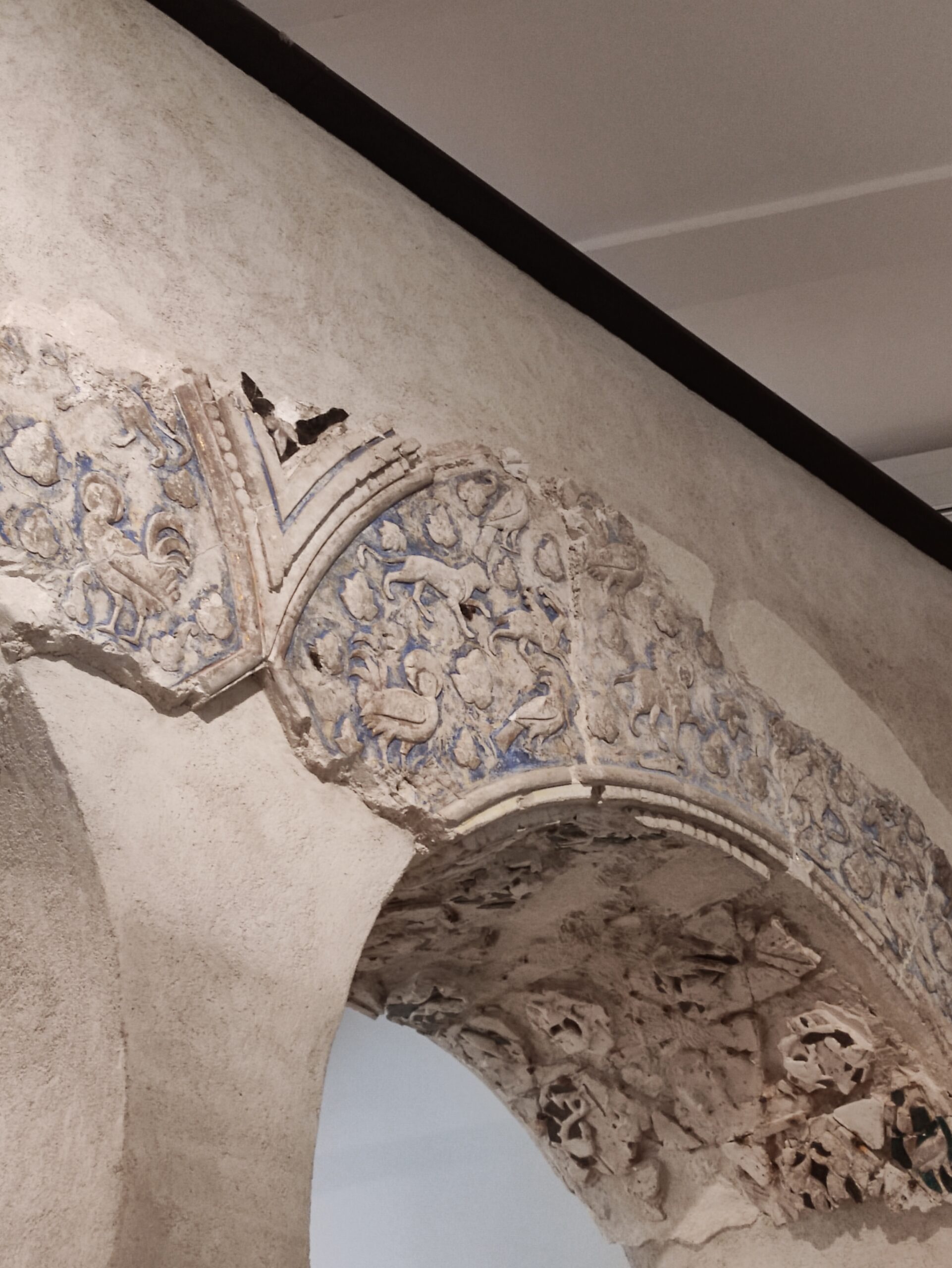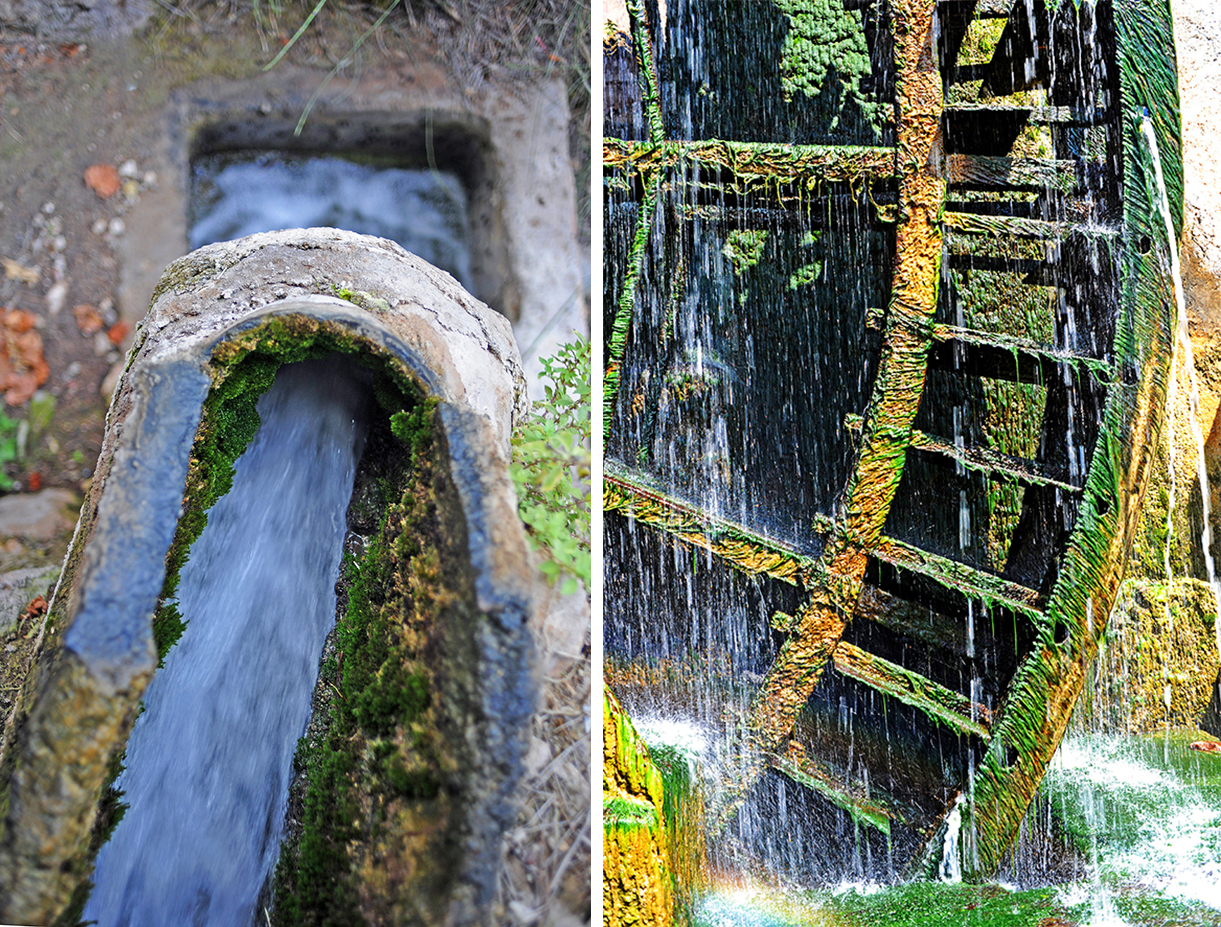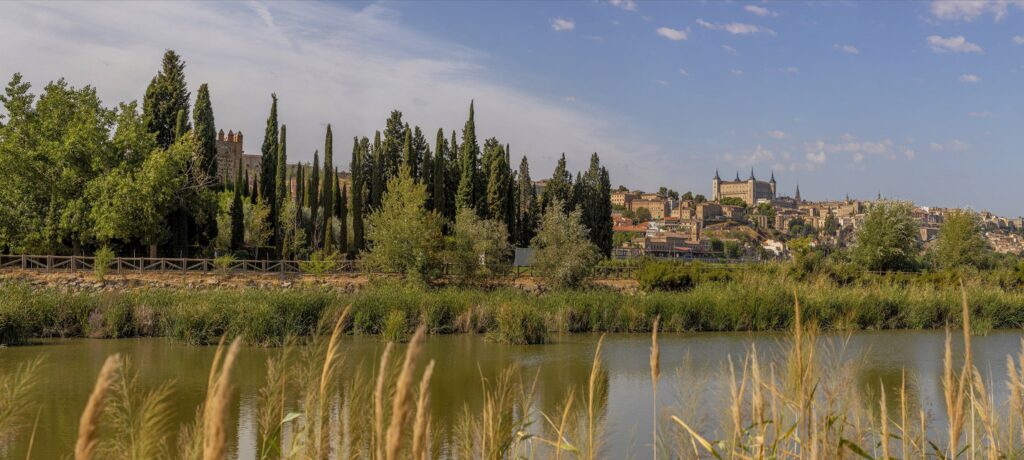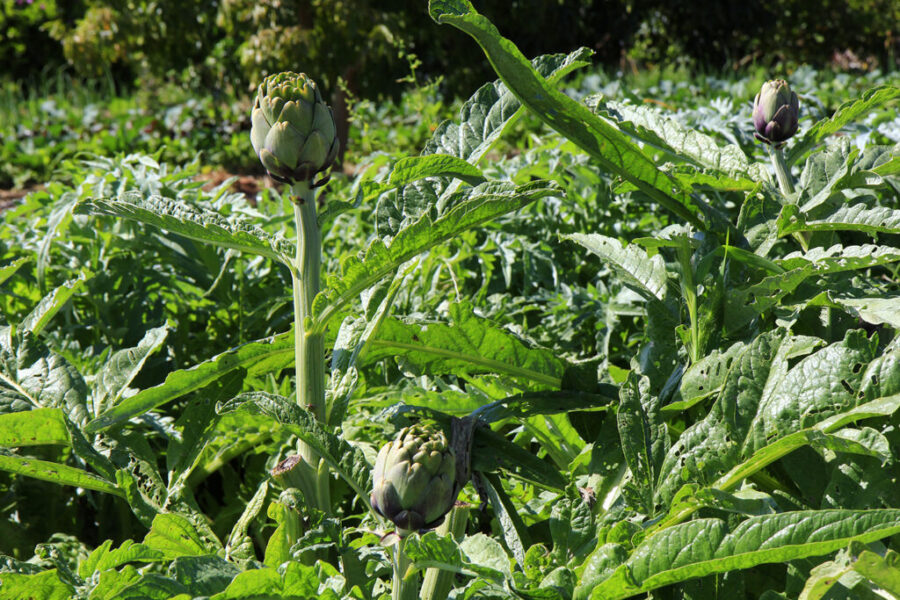Sergio Isabel Ludeña – FUNCI
The sovereigns of the Banu Di-l-Nun dynasty of the Taifa of Toledo maintained a notable protection and patronage of artists and scientists, among whom agronomists such as Ibn Wāfid and Ibn Bassāl, who established the seed of a school of naturalists of extensive importance, were particularly outstanding. A project of particular importance for the monarch al-Ma’mun, who sought to legitimise and enhance his figure and his kingdom, was the royal almunia of Tulaytula.
Brief historical context: Tulaytula between the Taifa kingdoms
The Taifa kingdoms created in the 11th century, after the process of decomposition of the Caliphate of Córdoba, lost the strength of this preceding state and suffered considerable political instability, especially aggravated by their internal struggles, but also by the pressures they were under from the Christian kingdoms to the north, including León, Castilla, Galicia, Asturias and Nájera, led by Alfonso VI, as well as the Almoravid Empire to the south. However, these taifas stood out for their refinement and cultural splendour, probably unparalleled in al-Andalus up to that time.
Tulaytula became one of the most active creative centres, where many different fields of knowledge were developed.
The Taifas sought consolidation through an image that linked them to the caliphate and oriental models and used the ostentation of art, science and wealth (luxury, but also culture). The strength that they could not achieve with the division of al-Andalus through armies was obtained with these elements (Calvo, 2011, 69).

In the case of Toledo, it seems that the Taifa became one of the most important centres of knowledge in the 11th century. Although there are signs that this policy of patronage of science and the arts began in the reign of al-Zafir, it was under al-Ma’mun that it reached its peak. Under his rule, Tulaytula became one of the most active creative centres, where many different fields of knowledge were developed: astronomy, botany, legal sciences, philosophy, literature, medicine, etc. (Izquierdo, 2018, 424).
The rise of Nature Sciences in Tulaytula
Despite the interest in the advances achieved by some of these disciplines in Toledo during this period, such as those made by the renowned astronomer Azarquiel, in the case of this article we are more interested in dealing with the field of the Natural Sciences, one of the most developed in this Taifa, especially with regard to agronomy, botany and other related knowledge, such as pharmacology and zoology [1]. In fact, what has been called the Andalusi agronomic school or school of naturalists had its origins in this context in the 11th century and would come to stand out for the high level of knowledge achieved, whose antecedents are to be found in the knowledge accumulated in the Caliphate of Córdoba from the Arab science of the Iranian and Hellenistic tradition (García, 1999, 135).
The Taifas sought consolidation through an image that linked them to Caliphate and Eastern models and employed artistic ostentation, the development of science and wealth.
There is no evidence of any authors dedicated to the sciences of nature in Toledo prior to the patronage of the Banu Di-l-Nun, but it seems that they came from other parts of al-Andalus, such as Córdoba, attracted by the kings of the Taifa. One of the first who is known to have come to Tulaytula in this way was Ibn al-Bagunis, an astronomer, mathematician, physician and naturalist, who was one of the most famous teachers in Caliphate Córdoba and became a member of the court of Toledo in the time of al-Zafir. In addition to his activity as advisor to the Di-l-Nun kings, he also wrote some botanical and pharmacological works (García, 1999, 136).
During the 11th century, the epicentre of agronomic knowledge in al-Andalus moved to Toledo. The driving force behind the future school of agronomy must be attributed to Ibn Wāfid, which was continued by his disciples, among whom Ibn al-Luengo and Ibn Bassāl are known. This heyday of agronomic studies also included other related disciplines, namely botany and pharmacology, which were also worked on by these scientists (Téllez, 1999, 49).
Agronomists of Toledo: Ibn Wāfid
One of Tulaytula’s most important agronomists was Ibn Wāfid. Born in Toledo between 997 and 1008, from a noble lineage of Cordovan origin, he studied various disciplines in Córdoba in his youth, including medicine, philosophy and law. It is not entirely clear how he acquired his knowledge of agriculture and botany, but it probably came from the study of works such as al-Zahrawi’s “Tasrif” (García, 1999, 137). His return to his native city was in the time of al-Ma’mun, at whose court he fulfilled the dual role of politician and scientist, where he excelled as a physician and agronomist.
The importance given to gardens by the Muslims, especially by the higher classes who could afford them, offered a new field of action for the agronomists of the Taifas.
It is important to note the importance that agronomy achieved in al-Andalus in order to understand the role of figures such as Ibn Wāfid. It must be considered that agricultural products were the food support of the Andalusi population, and therefore the improvements introduced by agronomists in terms of the extension of irrigation systems, the importation of new crops and the application of techniques such as grafting and fertilisation had as a direct consequence an increase in production and a true agricultural revolution (Téllez, 1999, 50). Moreover, the importance given to gardens by the Muslims, especially by the higher classes who could afford them, offered a new field of action for the agronomists of the Taifas. Botanical gardens played a fundamental role in enhancing the political-religious power of their owners (Tito and Casares, 2011, 32), among which the one at the royal almunia of al-Ma’mun in Toledo stood out. In this gardens, the agronomists would experiment with different techniques, such as the acclimatisation of new foreign species to their gardens and the exploitation of the nutritional, pharmacological or aesthetic properties of the plants (García, 2018, 19).

As for Ibn Wāfid’s works, it has been possible to confirm with certainty two of them devoted to medicine (“The Book of the Pillow” and “The Book of Simple Medicines”), which reflect his profound knowledge of this field (Aguirre, 1992, 180), and, although there has been much debate among specialists, perhaps one on agriculture (“Sum of Agriculture”). It is necessary to point out, since the content of these works cannot be explained in detail here due to the extension of this article, that this author is characterised by a compiling style of the knowledge of his predecessors, with few elements of criticism or personal commentary (Guzmán, 2005, 87).
Although not many other elements of his biography have come down to us, we do know that al-Ma’mún made him responsible for the execution of the project of his personal almunia and its corresponding orchards and gardens (Téllez, 1999, 55). It must have been an immense project to realise this palatial building and its ensemble, on which he collaborated with several of his disciples, but also an opportunity for experimentation in different agronomic projects. However, his great work, the Royal Almunia of Toledo, was to be relatively short-lived, but Ibn Wāfid was not even able to see the end of Toledo’s splendour, as he died in 1074 or 1075.

Agronomists of Toledo: Ibn al-Luengo and Ibn Bassāl
Only two names are known of the disciples that Ibn Wāfid may have had in Toledo: Ibn al-Luengo and Ibn Bassāl, of whom a rather uneven knowledge has survived, probably because the importance of the latter’s writings far outweighed that of the former.
Ibn al-Luengo became an alfaqi and devoted himself to medicine and botany. His date of birth is not known with certainty, but from his friendship with Ibn Bassāl and the tutelage of Ibn Wāfid, he may have been around the age of Ibn Bassāl. Some sources have attested that he experimented with the acclimatisation of imported plant species, so he may have been linked to the project of the royal sheepfold of al-Ma’mun and its botanical garden. It seems that he died in 1105, having moved after the fall of Toledo, first to Badajoz and then to Seville and Córdoba (García, 1999, 142).
His work was widely disseminated, It crossed the borders of the Andalusi world and travelled throughout the Islamic world, passing through North Africa and the Middle East.
The last of the Toledan botanists and agronomists is Ibn Bassāl. He is thought to have been born around 1050, although no specific date has been confirmed, in Toledo. He was fortunate enough to grow up at the height of the splendour of the court of al-Ma’mun, coming into contact with the important circle of intellectuals of the time and training under the tutelage of Ibn Wāfid (Téllez, 1999, 55). Unlike his master and many other scholars of his time, he had the peculiarity of dedicating himself essentially to the agricultural world.
Ibn Bassāl participated together with his colleague Ibn Luengo in the project of the royal almunia headed by his master Ibn Wāfid, whom he replaced after his death in the direction of the latter. His work on the acclimatisation of new species has always been mentioned (García, 1999, 143), but I consider it quite probable that he played a role in other areas related not only to the botanical garden, but also to the orchards of the royal complex, agricultural aspects of which he had a profound knowledge. Furthermore, in connection with the royal almunia, it is known that he made a journey around the Mediterranean, which took him to the Islamic East, passing through places such as Sicily, Egypt, the Arabian Peninsula, Syria and northern India, with the task of collecting new plant species and seeds that could later be acclimatised in the botanical garden of al-Ma’mun (Téllez, 1999, 56). What he learnt on this journey must have been added to the knowledge he had previously acquired with his master and from his experiments in the orchards and gardens of Toledo.

Several agronomic works by Ibn Bassāl are documented, but the most important is “The Book of Agriculture”, which was dedicated to al-Ma’mun (Carabaza and García, 2001, 106). Unlike Ibn Wāfid, his texts were notable for their practical character. He dealt with aspects related to land, water, fertilisers, seeds, workers, pests, the cultivation of different plant species, home economics and zootechnics. This is possibly the reason why his work was widely disseminated. It crossed the borders of the Andalusi world and travelled throughout the Islamic world, passing through North Africa and the Middle East, where his knowledge of the treatment of soil and water, urbiculture and ornamental plants was applied (García, 1999, 145-149).
The end of the reign of al-Ma’mun brought profound instability to the Taifa of Toledo. The rapid decline of the monarch’s power, in the figure of al-Qadir, and the Christian conquest of 1085 put an end to the germ of an agronomic school in Tulaytula. However, with Ibn Bassāl it is possible to see a continuity of this group. Having moved to Seville, where he also took part in its royal orchard, he kept a large number of students, including Ibn al-Lunquh, Abu l-Jayr and al-Tignari, to whom he passed on his knowledge of agronomy and botany, which kept the school of Andalusi naturalists alive and gave it continuity (Téllez, 1999, 56).
Notes
[1] For more information on scientific development in al-Andalus, see: Samsó, 2011.
Bibliography
AGUIRRE, L. F. (1992): El texto árabe de El libro de los medicamentos simples de Ibn Wafid. Anaquel de Estudios Árabes, 3, 175-182.
CALVO, S. (2011): El arte de los reinos taifas: tradición y ruptura. Anales de Historia del Arte, vol. extra (2): Alfonso VI y el arte de su época, 60-92.
CARABAZA, J. M. y GARCÍA, E. (2001): Estado actual y perspectivas de los estudios sobre agronomía andalusí. El saber en al-Ándalus, 3, 101-118.
GARCÍA, E. (1999): Botánica y Agronomía en Toledo. Entre el Califato y la taifa. Mil años del Cristo de la Luz, Asociación del Toledo Islámico. Toledo, 135-152.— (2018): Terminología y funcionalidad de las almunias andalusíes a través de los textos agronómicos. Almunias. Las fincas de las élites en el Occidente islámico: poder, solaz y producción, Universidad de Granada, Granada, 17-26.
GUZMÁN, J. R. (2005): El compendio de agricultura atribuido a Ibn Wafid. Anaquel de Estudios Árabes, 16, 83-124.
IZQUIERDO, R. (2018): Toledo y su taifa. Tawa’if: Historia y arqueología de los reinos de taifas, Alhulia, Salobreña, 411-446.
SANSÓ, J. (2011): Las Ciencias de los Antiguos en al-Ándalus. Fundación Ibn Tufayl de Estudios Árabes, Almería.
TÉLLEZ, J. (1999): Dos agrónomos toledanos: Ibn Wâfid e Ibn Bassâl, y la Huerta del Rey. Tulaytula, Asociación de Amigos del Toledo Islámico, Toledo, 49-58.
TITO, J. y CASARES, M. (2011): El jardín hispanomusulmán: Los jardines de al-Ándalus y su herencia, Universidad de Granada, Granada.
Sergio Isabel Ludeña – FUNCI
This post is available in: English Español

